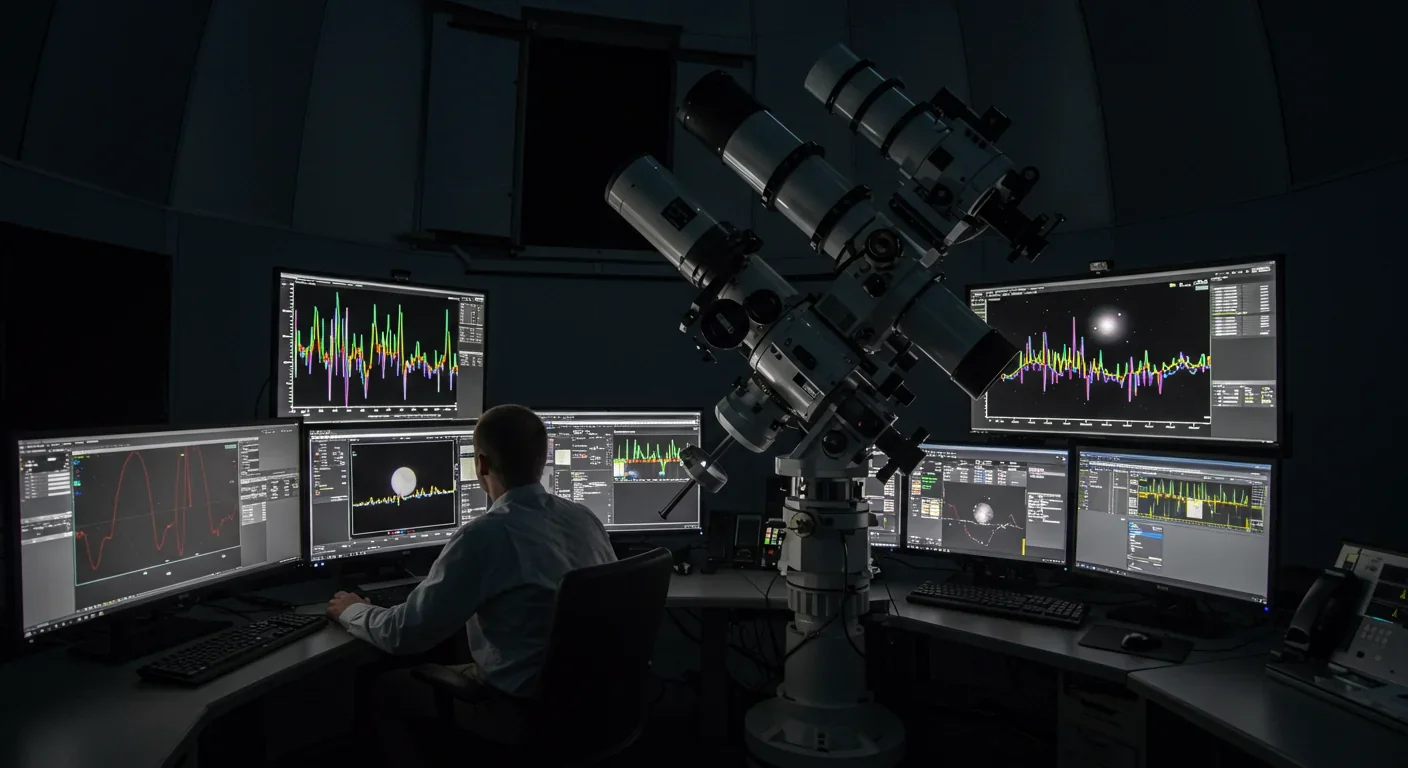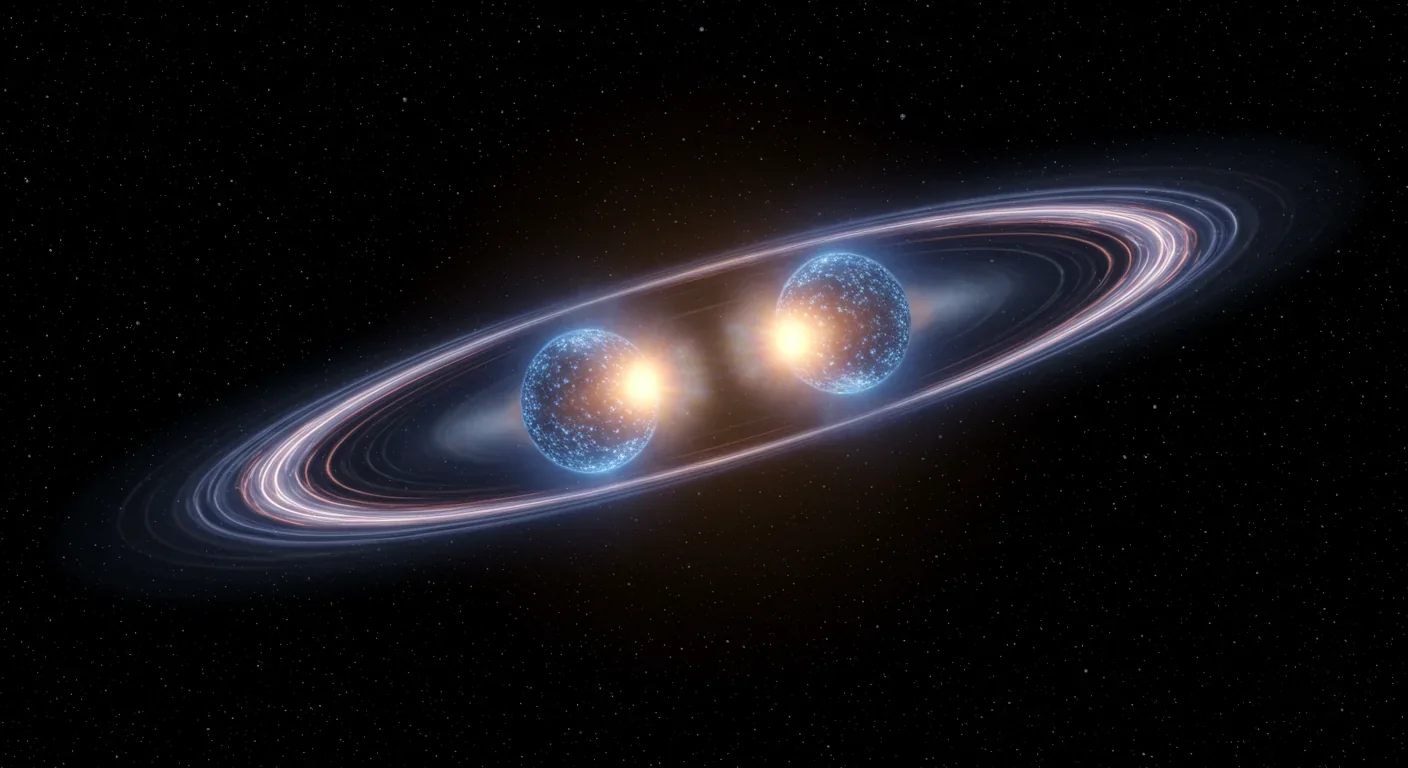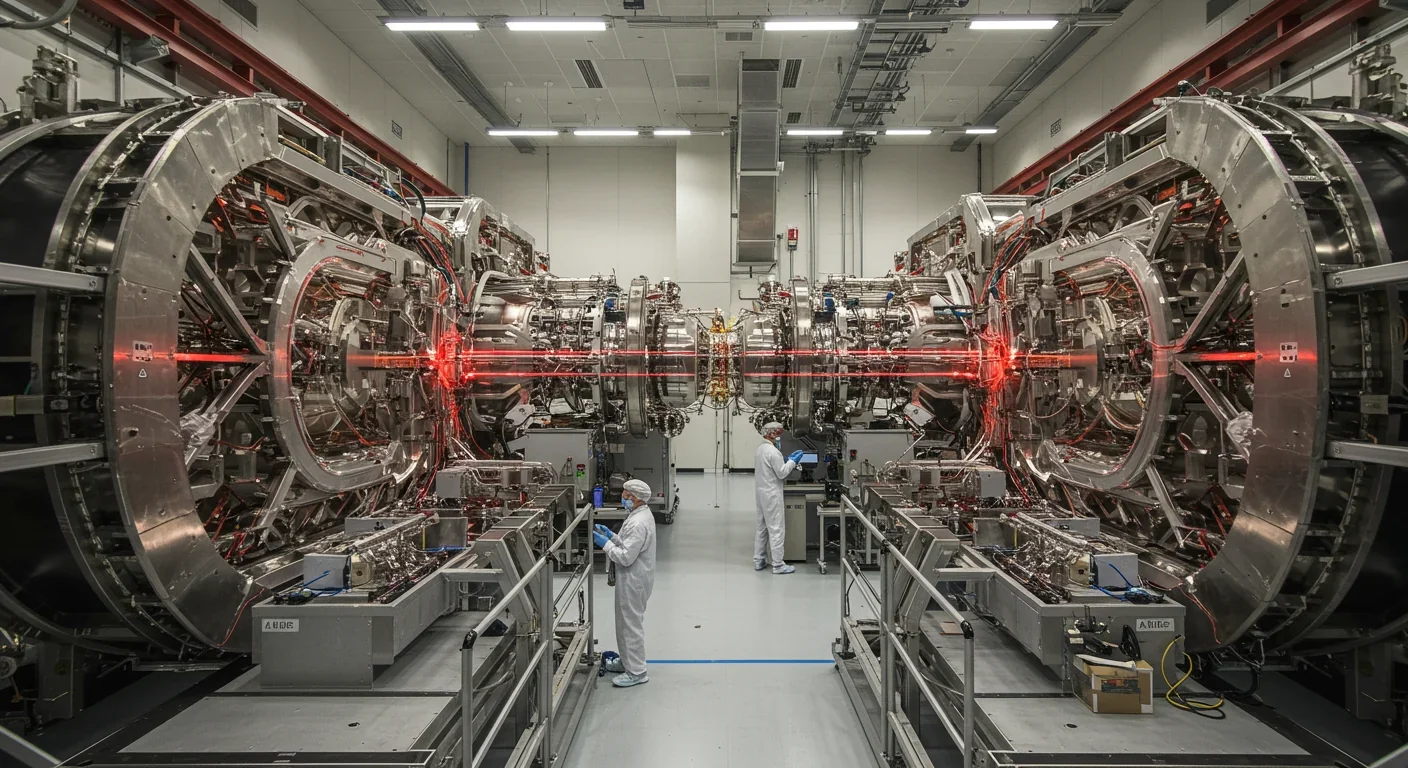White Dwarf Spectroscopy Reveals Destroyed Exoplanets

TL;DR: On August 17, 2017, scientists detected gravitational waves from two colliding neutron stars 130 million light-years away—the first direct observation of how gold, platinum, and other heavy elements are forged in the universe. This merger created roughly 10 Earth masses of gold in seconds, confirming that neutron star collisions are cosmic foundries responsible for about half of all elements heavier than iron. The discovery inaugurated multimessenger astronomy, combining gravitational wave detection with electromagnetic observations to reveal not just that massive objects collide, but the nuclear alchemy that occurs when they do.

The gold in your wedding ring, the platinum in your electronics, and the uranium powering nuclear reactors all share an improbable origin story: they were forged in the violent death throes of colliding neutron stars, events so energetic they ripple the fabric of spacetime itself. On August 17, 2017, humanity witnessed this cosmic alchemy for the first time when gravitational wave detectors caught two neutron stars spiraling into each other 130 million light-years away—a collision that created roughly 10 Earth masses of gold and platinum in mere seconds.
For decades, scientists puzzled over where the universe's heaviest elements came from. Ordinary stellar fusion stops at iron—the periodic table's dead end, where nuclear reactions cease to release energy. Everything heavier requires an injection of tremendous power. The answer arrived in 2017 with event GW170817, detected simultaneously by LIGO's gravitational wave observatories and seventy telescopes worldwide.
What made this observation revolutionary wasn't just detecting the gravitational waves—ripples in spacetime traveling at light speed—but capturing the electromagnetic fireworks that followed. Within 1.7 seconds, the Fermi Gamma-ray Space Telescope spotted a short gamma-ray burst. Eleven hours later, optical telescopes identified a kilonova, a new type of cosmic explosion that glowed blue, then red over several days as freshly minted heavy elements decayed.
The spectroscopic fingerprints were unmistakable. Instruments detected strontium, lanthanum, and other heavy elements that could only form through the rapid neutron-capture process—the r-process—where atomic nuclei gorge on neutrons faster than they can radioactively decay. "From informing detailed models of the inner workings of neutron stars to more fundamental physics such as general relativity, this event is just so rich," said David Shoemaker, spokesperson for the LIGO Scientific Collaboration. "It is a gift that will keep on giving."
This single observation confirmed what had been theoretical speculation: neutron star mergers are cosmic foundries responsible for roughly half of all elements heavier than iron in the universe.
The quest to understand where elements come from stretches back millennia. Medieval alchemists dreamed of transmuting lead into gold, unaware they were asking the right question with impossibly limited tools. The modern answer began taking shape in 1957 when physicists Margaret and Geoffrey Burbidge, William Fowler, and Fred Hoyle published their landmark B²FH paper outlining stellar nucleosynthesis—how stars forge lighter elements through fusion.
But the heaviest elements presented a stubborn problem. Calculations showed that even the most massive stars couldn't produce gold, platinum, or uranium in observed quantities. Something more extreme was needed. Theorists proposed the r-process in the 1950s, requiring environments with neutron densities a billion trillion times denser than water and temperatures exceeding 10 billion degrees Kelvin.
For sixty years, the astrophysical site of this process remained speculative. Candidates included core-collapse supernovae and colliding neutron stars, but without direct observation, the mystery persisted. Just as the printing press democratized knowledge by making information widely accessible, gravitational wave astronomy has democratized cosmic observation by making previously invisible events detectable. LIGO's interferometers measure spacetime distortions smaller than one ten-thousandth the width of a proton—a technological marvel that took decades to perfect.
The 2015 detection of gravitational waves from merging black holes proved the technology worked. Two years later, GW170817 showed it could reveal not just that massive objects collide, but what happens when they do.
Gravitational wave detectors work on a principle so simple it sounds like science fiction: they measure changes in distance caused by passing ripples in spacetime. LIGO operates two L-shaped observatories—one in Louisiana, one in Washington—each with arms stretching 4 kilometers. Laser light bounces between mirrors at the ends of each arm thousands of times, creating an effective path length of 1,200 kilometers.
When a gravitational wave passes through, it stretches space in one direction while compressing it in the perpendicular direction. The detector measures the resulting difference in arm lengths using laser interferometry. The catch? The changes are absurdly small—about 10⁻¹⁸ meters, roughly one ten-thousandth the diameter of a proton.
To achieve this sensitivity, LIGO engineers had to eliminate every possible source of noise. The mirrors hang from sophisticated suspension systems that isolate them from seismic vibrations. The entire detector operates in ultra-high vacuum to prevent air molecules from scattering light. Advanced signal processing distinguishes gravitational wave signals from environmental noise like passing trucks, earthquakes, or even quantum fluctuations in the laser light itself.

The signal from GW170817 lasted approximately 100 seconds, rising in pitch and amplitude as the two neutron stars spiraled closer together at an accelerating rate. This characteristic "chirp" matches General Relativity's predictions precisely. The frequency started at 24 Hz—below human hearing—and swept upward to a few hundred Hz before cutting off abruptly when the stars merged.
By comparing the arrival times and signal strengths at multiple detectors (LIGO's two sites plus the Virgo detector in Italy), scientists triangulated the source to a region in the galaxy NGC 4993, about 130 million light-years away. This localization took just hours, enabling the unprecedented electromagnetic follow-up campaign.
Neutron star mergers don't just create heavy elements—they reshape entire fields of study. Consider the impact across disciplines:
Nuclear Physics: The extreme conditions inside merging neutron stars probe matter at densities exceeding atomic nuclei. Recent lattice quantum chromodynamics calculations show sound travels at approximately 0.75 times light speed through neutron star cores—about 30% faster than previous models predicted. This finding suggests neutron star matter is stiffer than expected, allowing these objects to support larger masses before collapsing into black holes.
Fundamental Physics: GW170817 constrained the difference between the speed of gravitational waves and light to better than one part in 10¹⁵. This measurement rules out entire classes of alternative gravity theories and confirms Einstein's General Relativity in a previously untested regime.
Cosmology: The same event provided an independent measurement of the universe's expansion rate. By comparing the gravitational wave signal (which reveals distance) with the host galaxy's redshift (which reveals recession velocity), scientists calculated the Hubble constant—a crucial parameter for understanding cosmic history.
Planetary Science: Earth's crust contains approximately 6.2 billion kilograms of gold. Geochemical evidence from meteorites suggests a neutron star merger occurred about 100 million years before our solar system formed, roughly 1,000 light-years away, seeding the pre-solar nebula with heavy elements. Every gold atom on Earth is likely 4.6 billion years old, formed when our planet coalesced from that enriched dust.
The industrial implications ripple across sectors. Gold's unique properties—excellent conductivity, resistance to corrosion, high reflectivity for infrared light—make it essential for space exploration. NASA coated the James Webb Space Telescope's mirrors with gold specifically because it reflects up to 98% of infrared radiation. Platinum group metals are critical for catalytic converters, hydrogen fuel cells, and cancer chemotherapy drugs.
GW170817 inaugurated a new era: multimessenger astronomy, where scientists observe cosmic events through multiple channels simultaneously. Imagine trying to understand a symphony by reading the score versus hearing the music while watching the orchestra. That's the difference between studying the electromagnetic spectrum alone versus combining it with gravitational waves, neutrinos, and cosmic rays.
Each messenger provides unique information. Electromagnetic waves reveal chemistry and temperature but can be absorbed or scattered by intervening matter. Gravitational waves pass through everything unchanged, carrying pristine information about massive object dynamics. Neutrinos interact so weakly they escape dense regions where light cannot, revealing conditions in stellar cores.
The August 2017 detection involved an unprecedented coordination of resources. LIGO Livingston and Hanford, plus Virgo in Italy, detected the inspiral and merger. Fermi and INTEGRAL satellites caught the short gamma-ray burst 1.7 seconds post-merger. The Swope Telescope in Chile identified the optical counterpart 11 hours later; dozens of facilities tracked it for weeks. Chandra X-ray Observatory detected emission appearing 9 days after merger and peaking around 150 days. The Very Large Array and other radio telescopes monitored the expanding remnant for months.
This multi-wavelength campaign revealed the merger's complete story. The initial gamma-ray burst came from a relativistic jet—a focused beam of particles and radiation moving at 99.97% light speed. The kilonova's blue color in the first day reflected fast-moving ejecta poor in lanthanides. Over subsequent days, the spectrum reddened as slower, lanthanide-rich material dominated the emission, its heavy elements absorbing blue light efficiently.
Spectroscopic analysis confirmed the presence of strontium and heavier elements, with abundance patterns matching r-process predictions. The total mass of heavy elements ejected—roughly 16,000 Earth masses—included approximately 3-10 Earth masses of gold specifically.
While neutron star merger observations promise revolutionary insights, several challenges deserve attention. GW170817 remains the only neutron star merger observed in both gravitational waves and electromagnetic radiation. The second confirmed binary neutron star merger, GW190425, produced no detected electromagnetic counterpart, possibly because its greater distance made the kilonova too faint, or because the viewing angle hid the emission.
Detection rates remain low—roughly one confirmed neutron star merger per year with current sensitivity. Fifth-generation detectors like Cosmic Explorer, planned for the 2030s, should increase sensitivity by a factor of ten, potentially detecting millions of mergers across cosmic time.
The equation of state of ultra-dense matter—how pressure relates to density inside neutron stars—remains uncertain. Different equations of state predict different maximum neutron star masses and different amounts of ejected material during mergers. Neutrino transport in the hot, dense merger environment strongly affects the composition of ejected matter, yet simulations using different neutrino transport schemes can vary by 10-30% in predicted remnant properties and outflow masses.
Magnetic fields, amplified to trillions of times Earth's strength during mergers, complicate interpretation. Recent studies show magnetic fields can shift post-merger oscillation frequencies enough to mask equation-of-state signatures in gravitational waves. Previous analyses that ignored magnetic effects may have been misleading.
While neutron star mergers produce copious heavy elements, they're relatively rare—occurring perhaps once every 100,000 years per galaxy. Recent research suggests magnetar giant flares might contribute up to 10% of galactic heavy elements, providing an additional production channel.

While the scientific consensus on neutron star mergers is international, cultural perspectives vary in fascinating ways. North American and European institutions have dominated gravitational wave astronomy, with LIGO and Virgo leading detection efforts. The approach emphasizes large-scale international collaboration, open data sharing, and rapid publication.
Japan's KAGRA detector represents Asia's entry into gravitational wave astronomy. Japanese and Chinese research groups have made significant theoretical contributions to understanding neutron star mergers, particularly in nuclear physics and equation-of-state modeling. China's planned Einstein Telescope would extend detection capabilities to higher redshifts, observing mergers from the universe's first billion years.
Limited infrastructure in developing nations creates disparities in participation, but remote telescope access and data-sharing initiatives democratize some aspects of follow-up observations. The Swope Telescope in Chile—which made the first optical identification of GW170817—exemplifies how strategically located facilities in the Southern Hemisphere provide crucial capabilities.
Gravitational wave astronomy is still in its infancy—roughly where electromagnetic astronomy was in Galileo's time. The next decade will see dramatic improvements. LIGO's A+ upgrade improves sensitivity by 60% through quantum squeezing and better mirror coatings. The FROSTI system allows real-time wavefront correction on LIGO's main mirrors even at megawatt laser powers.
India's LIGO-India, expected online by 2030, will improve sky localization. The Einstein Telescope would achieve ten times better sensitivity than current detectors. Cosmic Explorer would use 40-kilometer arms and potentially increase detection rates a thousandfold.
LISA, scheduled for launch in the 2030s, will detect gravitational waves from massive black hole mergers using spacecraft separated by 2.5 million kilometers. LISA's frequency range complements ground-based detectors, creating a multi-band gravitational wave astronomy.
For those inspired to contribute, several skill sets are valuable: data science and machine learning for signal detection, observational astronomy for electromagnetic follow-up, computational physics for merger simulations, nuclear physics for understanding r-process nucleosynthesis, and instrumentation expertise for building next-generation detectors.
Every gold atom in existence has a biography spanning billions of years. Born in a neutron star merger, scattered into space, incorporated into the pre-solar nebula, condensed into planetesimals, differentiated into Earth's core and crust, occasionally concentrated into ore deposits, mined, refined, and shaped into jewelry or electronics—the journey encompasses cosmology, geochemistry, and human civilization.
As Kip Thorne said: "Gravitational waves will bring the information from the birth of the universe to us." We're no longer limited to studying the universe through electromagnetic radiation alone. We can now listen to spacetime itself, hearing the songs of colliding black holes and neutron stars, decoding messages carried across billions of light-years unchanged by intervening matter.
Every time you glance at a gold ring or use a smartphone with platinum components, remember: those atoms were forged in apocalyptic collisions that briefly outshone entire galaxies, then scattered into space to eventually become part of you. We are, quite literally, made of star stuff—and the most exotic star stuff originates in the universe's most violent events.

Over 80% of nearby white dwarfs show chemical fingerprints of destroyed planets in their atmospheres—cosmic crime scenes where astronomers perform planetary autopsies using spectroscopy. JWST recently discovered 12 debris disks with unprecedented diversity, from glassy silica dust to hidden planetary graveyards invisible to previous surveys. These stellar remnants offer the only direct measurement of exoplanet interiors, revealing Earth-like rocky worlds, Mercury-like metal-rich cores, and ev...

Hidden mold in homes releases invisible mycotoxins—toxic chemicals that persist long after mold removal, triggering chronic fatigue, brain fog, immune dysfunction, and neurological damage. Up to 50% of buildings harbor mold, yet most mycotoxin exposure goes undetected. Cutting-edge airborne testing, professional remediation, and medical detox protocols can reveal and reverse this silent epidemic, empowering individuals to reclaim their health.

Data centers consumed 415 terawatt-hours of electricity in 2024 and will nearly double that by 2030, driven by AI's insatiable energy appetite. Despite tech giants' renewable pledges, actual emissions are up to 662% higher than reported due to accounting loopholes. A digital pollution tax—similar to Europe's carbon border tariff—could finally force the industry to invest in efficiency technologies like liquid cooling, waste heat recovery, and time-matched renewable power, transforming volunta...

Transactive memory is the invisible system that makes couples, teams, and families smarter together than apart. Psychologist Daniel Wegner discovered in 1985 that our brains delegate knowledge to trusted partners, creating shared memory networks that reduce cognitive load by up to 40%. But these systems are fragile—breaking down when members leave, technology overwhelms, or communication fails. As AI and remote work reshape collaboration, understanding how to intentionally build and maintain ...

Mass coral spawning synchronization is one of nature's most precisely timed events, but climate change threatens to disrupt it. Scientists are responding with selective breeding, controlled laboratory spawning, and automated monitoring to preserve reef ecosystems.

Your smartphone isn't just a tool—it's part of your mind. The extended mind thesis argues that cognition extends beyond your skull into devices, AI assistants, and wearables that store, process, and predict your thoughts. While 79% of Americans now depend on digital devices for memory, this isn't amnesia—it's cognitive evolution. The challenge is designing tools that enhance thinking without hijacking attention or eroding autonomy. From brain-computer interfaces to AI tutors, the future of co...

Transformers revolutionized AI by replacing sequential processing with parallel attention mechanisms. This breakthrough enabled models like GPT and BERT to understand context more deeply while training faster, fundamentally reshaping every domain from language to vision to multimodal AI.